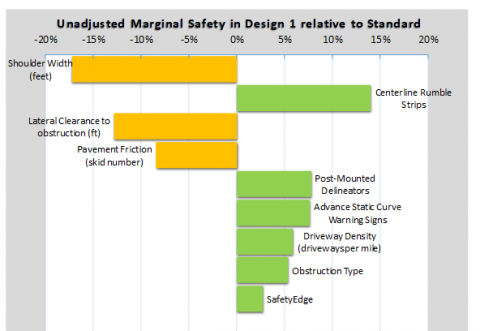
The Texas Transportation Commission has adopted a goal of zero fatalities on Texas roadways by 2050. Recognizing that new methods would be needed to reach this goal, the Texas Department of Transportation (TxDOT) retained the Texas A&M Transportation Institute to develop scoring tools that can be used to evaluate the effects of geometric, traffic control and roadside design elements on safety. The initial effort focused on two-lane and multi-lane rural roadway projects because a disproportionate number of fatalities and serious injuries occur on these roads.
The scoring tool incorporates quantified effects of changes in design parameters such as lane and shoulder width, horizontal and vertical curve geometry, rumble strips, and clearances to objects, thereby allowing project developers to examine the effects and tradeoffs involved in design decisions. Developed in a user-friendly, familiar spreadsheet format, the tool is not designed or intended to make decisions for the project developer, but rather to provide an objective, data-driven aid that allows the designer to assess and evaluate how changes in design parameters can affect safety. Feedback is provided through a visualization tornado-chart graph, dubbed the “Vortex of Safety”, which provides a proportional representation of the effect of design changes, and focuses the analyst on the primary means to improve safety in a project.
Use of the tool is required for all rural two and multi-lane non-access controlled projects, ranging from routine maintenance to complete reconstructions. The universal requirement emphasizes the importance of maximizing safety in the project development process for all types of projects, not just those primarily developed to improve safety. By incorporating proven Highway Safety Manual techniques, information from the crash modification clearinghouse, and findings from Texas-based research into an easy-to-use spreadsheet that requires very little training, the tool overcomes the barrier to widespread safety analysis stemming from the time and complexity of most safety analysis methods.
By requiring the use of this tool while projects are still in the development and design stage, the tradeoffs and costs of safety improvements can be evaluated before construction begins, resulting in cost-effective use of construction and maintenance funds. Importantly, integrating the tool into the process at this point also enables a proactive, rather than passive or reactive, approach to safety that strengthens the traffic safety culture throughout the state.
Agencies: Texas Department of Transportation and Texas A&M Transportation Institute
Project Contact: Robert Wunderlich, Director, Center for Transportation Safety, Texas A&M Transportation Institute
Email: rwunderlich@tamu.edu
Additional Information

FHWA Associate Administrator for Safety Cheryl Walker presented TxDOT and the Texas A&M Transportation Institute with their Award at the virtual ceremony October 6th.
